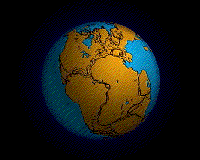Lesson 1: Continental Drift Theory
Video Lesson
Competencies
At the end of this lesson, you will be able to:
- Identify the continents that constituted Laurasia and Gondwanaland;
- Explain the geological evidences that support continental drift theory;
- Explain why Alfred Wegener continental drift theory was not easily accepted; and
- Describe how continental drift theory and plate tectonics are related.
- Explain what plate tectonic theory states;
Brainstorming Question
What is continental drift?
Have you answered the question? Good attempt! Well, now let’s see the following explanations.
Key Terms
- Pangaea
- Laurasia
- Gondwanaland
- Asthenosphere
- Lithosphere
The supercontinent that existed about 200-300 million years ago.
The northern part of Pangaea, which included North America and Eurasia.
The southern part of Pangaea, comprising South America, Africa, India, Australia, and Antarctica
A semi-fluid layer of the Earth’s mantle located below the lithosphere, which allows the lithospheric plates to move on top of it.
The rigid outer layer of the Earth, comprising the crust and the uppermost mantle, which is broken into tectonic plates that move over the asthenosphere.
1.1. Introduction and Historical Context
The Continental Drift Theory was proposed by Alfred Wegener, a German meteorologist and geophysicist, in 1910. This groundbreaking theory suggested that the continents were once joined together in a single landmass and have since drifted apart.

Figure 1.1 continental drift
Geological Evidences Favoring Continental Drift Theory
What evidences are there in support of continental drift theory?
A. Geological Evidence
Jigsaw fit of continents: The coastlines of continents, especially South America and Africa, fit together like puzzle pieces.

Similar rock formations: Matching rock types and ages found on different continents

Mountain chain continuity: Mountain ranges that appear to be continuations across different continents.
Figure 1.2: Geological evidences
B. Paleontological Evidence
- Fossil distribution: Similar fossils found on now-separated continents
- Example: Mesosaurus fossils found in both South America and Africa
- Glossopteris flora: Fossil plants found across southern continents

Figure 1.3 Fossil Evidences
C. Paleoclimate Evidence
- Glacial deposits: Evidence of ancient glaciations in currently tropical areas
- Coal deposits: Presence of coal in Antarctica, indicating a warmer past climate.
Wegener’s Explanation of Continental Drift
Wegener proposed that the continents plowed through the ocean floor, driven by centrifugal and tidal forces. He suggested that this movement was ongoing, with continents still drifting today.
Initial Reception and Criticism
- Lack of mechanism: Wegener couldn’t explain how continents could move through the solid ocean floor.
- Professional bias: Wegener was a meteorologist, not a geologist.
- Insufficient evidence: Some scientists felt the evidence was not conclusive
- Rapid timeline: The proposed rate of continental movement seemed implausibly fast
Significance and Legacy
Although initially rejected, Wegener’s theory:
- Challenged the prevailing “fixist” view of Earth’s geography
- Inspired further research into Earth’s geological processes
- Laid the groundwork for the development of plate tectonics theory
Connection to Modern Plate Tectonics
Continental drift theory evolved into the theory of plate tectonics, which explains the mechanism of continental movement through the concept of lithospheric plates moving on the asthenosphere.

Figure 1.4 Continental Drift
Remember: The Continental Drift Theory was a crucial stepping stone in our understanding of Earth’s geological processes, paving the way for modern plate tectonics theory.
1.1.2. Plate Tectonics Theory
Introduction
Brainstorming Activity: Can you list some of the geological features or phenomena as you can think of (e.g., mountains, earthquakes, and volcanoes)?
Plate Tectonic Theory, developed in the 1960s, is a comprehensive model explaining the large-scale motions of Earth’s lithosphere. It evolved from and expanded upon the theory of continental drift.

Figure 1.5: Plate Tectonic Theory
Key Concepts
Lithosphere: The rigid outer layer of the Earth, including the crust and uppermost mantle.
Asthenosphere: The ductile, partially molten layer beneath the lithosphere
Tectonic plates: Large sections of the lithosphere that move relative to one another
Plate boundaries: Areas where plates meet and interact

Figure 1.6 Major tectonic plates and their boundaries
